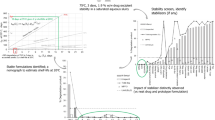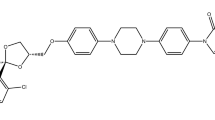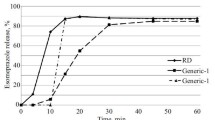Abstract
An intravenous solution is a dosage forms intended for administration into the bloodstream. This route is the most rapid and the most bioavailable method of getting drugs into systemic circulation, and therefore it is also the most liable to cause adverse effects. In order to reduce the possibility of side effects and to ensure adequate clinical dosage of the formulation, the primarily formulated composition should be optimized. It is also important that the composition should retain its therapeutic effectiveness and safety throughout the shelf-life of the product. This paper focuses on the optimization and stability testing of a parenteral solution containing miconazole and ketoconazole solubilized with a ternary solvent system as model drugs. Optimization of the solvent system was performed based on assessing the risk/benefit ratio of the composition and its properties upon dilution. Stability tests were conducted based on the EMEA (European Medicines Agency) “guideline on stability testing: stability testing of existing active substances and related finished products”. Experiments show that both the amount of co-solvent and surface active agent of the solvent system could substantially be reduced, while still maintaining adequate solubilizing power. It is also shown that the choice of various containers affects the stability of the compositions. It was concluded that by assessing the risk/benefit ratio of solubilizing power versus toxicity, the concentration of excipients could be considerably decreased while still showing a powerful solubilizing effect. It was also shown that a pharmaceutically acceptable shelf-life could be assigned to the composition, indicating good long-term stability.






Similar content being viewed by others
References
Yalkowsky SH, Krzyzaniak JF, Ward GH. Formulation-related problems associated with intravenous drug delivery. J Pharm Sci. 1998;87:787–96.
Egger-Heigold B. The effect of excipients on pharmacokinetic parameters of parenteral drugs (dissertation). Basel; 2005.
Torrado S, Torrado S, Cadorniga R, Torrado JJ. Formulation parameters of albendazole solution. Int J Pharm. 1996;140:45–50.
Alvarez-Núñez FA, Yalkowsky SH. Buffer capacity and precipitation control of pH solubilized phention formulations. Int J Pharm. 1999;185:45–9.
Sweetana S, Akers MJ. Solubility principles and practice for parenteral drug dosage form development. PDA J Pharm Sci Tech. 1999;50(5):330–42.
Ni N, Sanghvi T, Yalkowsky SH. Solubilization and preformulation of carbendazim. Int J Pharm. 2002;244:99–104.
Rangel-Yagui CO, Pessoa-Jr A, Tavares LC. Micellar solubilization of drugs. J Pharm Pharmaceut Sci. 2005;8(2):147–63.
Lamas MC, Villaggi L, Nocito I, Bassani G, Leonardi D, Pascutti F, et al. Development of parenteral formulations and evaluation of the biological activity of the trypanocide drug benznidazole. Int J Pharm. 2006;307:239–43.
Lin HS, Chean CS, Ng YY, Chan SY, Ho PC. 2-Hydroxypropyl-β-cyclodextrin increases aqueous solubility and photostability of all-trans-retinoic acid. J Clin Pharm Ther. 2000;25:265–9.
Brazeau GA, Cooper B, Svetic KA, Smith CL, Gupta P. Current perspectives on pain upon injection of drugs. J Pharm Sci. 1998;87:667–77.
Kryzaniak JF, Raymond DM, Yalkowsky SH. Lysis of human red blood cells 2: effect of contact time on cosolvent induced hemolysis. Int J Pharm. 1997;52:193–200.
Amin K, Dannenfelser RM. In vitro hemolysis: guidance for the pharmaceutical scientist. J Pharm Sci. 2006;95:1173–6.
Krzyzaniak JF, Alvarez Nunez FA, Raymond DM, Yalkowsky SH. Lysis of human red blood cells. 4. Comparison of in vitro and in vivo hemolysis data. J Pharm Sci. 1997;86:1215–7.
Lowe K, Furmidge B, Thomas S. Haemolytic properties of pluronic surfactants and effects of purification. Artif Cell Blood Substit Immobil Biotechnol. 1995;23:135–9.
Al-Assadi H, Baillie AJ, Florence AT. The haemolytic activity of non-ionic surfactants. Int J Pharm. 1989;53:161.
Riess JG, Pace S, Zarif L. Highly effective surfactants with low hemolytic activity. Adv Mat. 1991;3:249–51.
Ohnishi M, Sagitani H. The effect of nonionic surfactant structure on hemolysis. J Am Oil Chem Soc. 1993;70:679–84.
Pourroy B, Botta C, Solas C, Lacarelle B, Braguer D. Seventy-two-hour stability of Taxol® in 5% dextrose or 0.9% sodium chloride in Viaflo®, Freeflex®, Ecoflac® and Macoflex N® non-PVC bags. J Clin Pharm Ther. 2005;30:155–458.
McGookin AG, Millership JS, Scott EM. Miconazole sorption to intravenous infusion sets. J Clin Pharm Ther. 1989;12:433–7.
Kovács K, Stampf Gy, Klebovich I, Antal I, Ludányi K. Aqueous solvent system for the solubilization of azole compounds. Eur J Pharm Sci. 2009;36:352–8.
Piel G, Evrard B, Fillet M, Llabres G, Delattre L. Development of a non-surfactant parenteral formulation of miconazole by the use of cyclodextrins. Int J Pharm. 1998;169:15–22.
Taneri F, Güneri T, Aigner Z, Kata M. Influence of cyclodextrin complexation on the physicochemical and biopharmaceutical properties of ketoconazole. J Incl Phenom Macro Chem. 2003;47:15–23.
Gelderblom H, Verweij J, Nooter K, Sparreboom A. Cremophor EL: the drawbacks and advantages of vehicle selection for drug formulation. Eur J Cancer. 2001;37:1590–8.
Gupta SL, Patel JP, Jones DL, Partipilo RW. Parenteral formulation development of renin inhibitor Abbott-72517. PDA J Pharm Sci Tech. 1994;48:86–91.
Barillaro V, Bertholet P, de Hassonville SH. Effect of acidic ternary compounds on the formation of miconazole/cyclodextrin inclusion complexes by means of supercritical carbon dioxide. J Pharm Pharmaceut Sci. 2004;7:378–88.
Crane IM, Mulhern MG, Nema S. Stability of reconstituted parecoxib for injection with commonly used diluents. J Clin Pharm Ther. 2003;28:363–9.
Krishna G, Hodnick WF, Lang W, Lin X, Karra S, Mao J, et al. Pharmaceutical development and manufacturing of a parenteral formulation of a novel antitumor agent, VNP40101M. AAPS PharmsciTech. 2001;2(3):article 14.
Guideline on stability testing: stability testing of existing active substances and related finished products (CPMP/QWP/122/02)
Amin K, Dannenfelser RM. In vitro hemolysis: guidance for the pharmaceutical scientist. Wiley InterScience. 2007. doi: 10.1002/jps.20627.
Krzyzaniak JF, Raymond DM, Yalkowsky SH. Lysis of human red blood cells 2 effect of contact time on cosolvent induced hemolysis. Int J Pharm. 1997;152:193–200.
Krzyzaniak JF, Raymond DM, Yalkowsky SH. Lysis of human red blood cells 3 effect of contact time on surfactant induced hemolysis. J Pharm Sci Technol. 1998;52:66–9.
Ross BP, Braddy AC, McGeary RP, Blanchfield JT, Prokai L, Toth I. Micellar aggregation and membrane partitioning of bile salts, fatty acids, sodium dodecyl sulfate, and sugar-conjugated fatty acids: Correlation with hemolytic potency and implications for drug delivery. Mol Pharm. 2004;1:233–45.
Yalkowsky SH. Solubility and solubilization in aqueous media. New York: Oxford University Press; 1999.
Völgyi G, Deák K, Vámos J, Valkó K, Takács-Novák K. RPTLC determination of log P of structurally diverse neutral compounds. J Planar Chrom. 2008;21:143–9.
Author information
Authors and Affiliations
Corresponding author
Rights and permissions
About this article
Cite this article
Kovács, K., Antal, I., Stampf, G. et al. Composition Optimization and Stability Testing of a Parenteral Antifungal Solution based on a Ternary Solvent System. AAPS PharmSciTech 11, 285–293 (2010). https://doi.org/10.1208/s12249-009-9368-1
Received:
Accepted:
Published:
Issue Date:
DOI: https://doi.org/10.1208/s12249-009-9368-1




